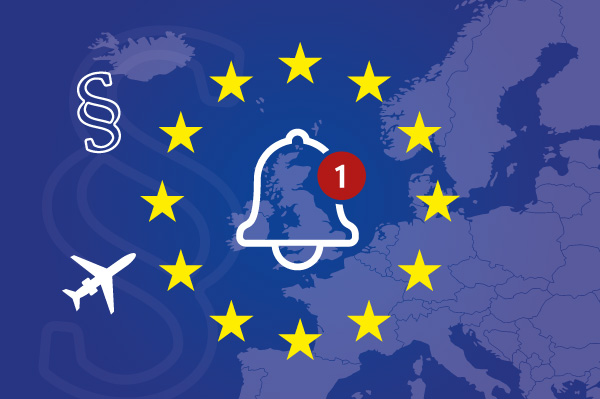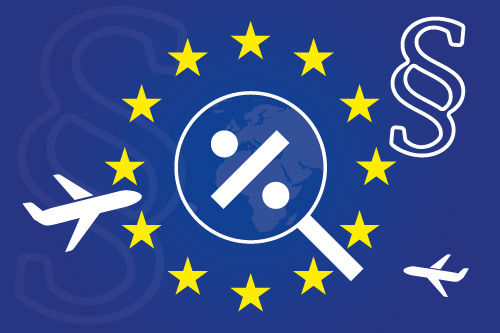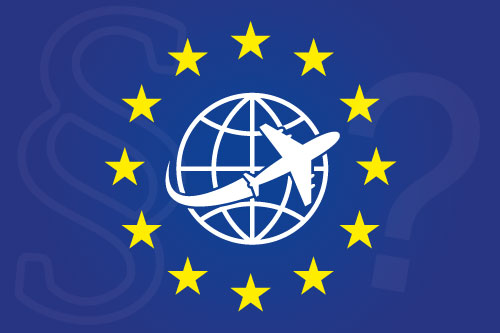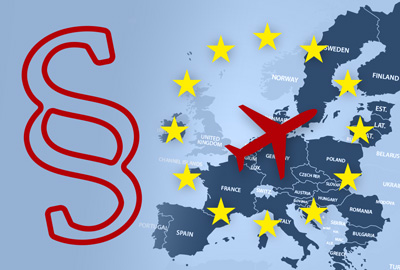BREAKING NEWS: Important amendment to the EU Union Customs Code
JULY 2020
- About Temporary Admission, what is actually needed when arriving within the EU?
- This is the most significant update of the EU Union Customs Code in many years
![]() When an aircraft arrives within the EU it has for many years been common practice that barely crossing the outer EU border activates the Temporary Admission (TA) authorization, meaning that it is not mandatory to file any formal customs paperwork in order to initiate the use of the TA regulation. The understanding is that the flight plan itself is considered a declaration when flying to a customs airport as entry point within the EU. The entry has always been accepted without any formality as it is taken for granted that the operator knows the entry criteria and limitations when using TA. In addition, the same happens when crossing an EU border on the way back as this is treated as an exit.
When an aircraft arrives within the EU it has for many years been common practice that barely crossing the outer EU border activates the Temporary Admission (TA) authorization, meaning that it is not mandatory to file any formal customs paperwork in order to initiate the use of the TA regulation. The understanding is that the flight plan itself is considered a declaration when flying to a customs airport as entry point within the EU. The entry has always been accepted without any formality as it is taken for granted that the operator knows the entry criteria and limitations when using TA. In addition, the same happens when crossing an EU border on the way back as this is treated as an exit.
The above has never been specified precisely in the EU Union Customs Code and whether this is indeed the correct approach has therefore occasionally been questioned. The EU Union Customs Code will now be updated to actually reflect the above practice.
This amendment is only meant to clarify the need for documentation when arriving and departing the European Union. The criteria for using TA and the correct application of the related limitations, like having EU residents onboard, have NOT changed.The change will take effect on the 16th, of July 2020.
What is the conclusion?
The present practice has not changed, but it is very positive that this practice has been explicitly ratified by the EU Commission.
What about the Supporting Document?
Based on the above, it has again been confirmed that the use of the TA Supporting Document (SD) is not mandatory but can be used as a tool to document how the aircraft has been flying in and out of the EU. In addition, the correct use of the SD will show customs that the operator knows at least a little about the TA regulation. The use of the SD can, therefore, be beneficial for purposes other than merely documenting the entry/exit points.
What must an operator always be ready to document when flying within the EU?
1. the flight pattern within the EU (use the Supporting Document and flight logs OR just flight logs, etc.)
2. compliance with the TA regulation; all criteria are met with the correct application of the limitations
How can OPMAS help – including our free service
If the aircraft arrives in Denmark as the first/last stop within the EU, we will gladly take care of the process and ask the Danish customs to stamp the SD for a minimal fee. We will also be glad to prepare the SD with the correct declarant and aircraft data, so that the crew can use the SD themselves and ask local customs at the arriving airport to stamp the SD if the aircraft’s route does not include Denmark. We will not charge anything for this service, but please be aware of the criteria and limitations when using TA and the SD this way.
We also offer an analysis of the owner/user/operator scenario to secure compliance with the TA regulation and provide guidance for the correct use of the TA. Hereafter, we secure the specific set-up and take care of all the supporting customs paperwork. Finally, we give specific instructions to the crew and OPS on how to fly within the EU.
Important to know
Any aircraft flying into the EU will fly under EU customs control either using the TA regulation or full importation. There are no other options. If the aircraft is not already fully imported, the aircraft will automatically be considered as flying under the TA regulation even though the owner or operator have not themselves taken any action to activate the TA regulation or realize that their aircraft is actually flying under the TA regulation. TA can only be used by entities and aircraft owned, operated, registered, and based outside the customs territory of the Union.
Selected links covering this issue![]() KNOW MORE: Temporary Admission: what are the 10 typical errors and misunderstandings?
KNOW MORE: Temporary Admission: what are the 10 typical errors and misunderstandings?![]() KNOW MORE: Survey 9: Is a Supporting Document valid for one EU-trip or multiple EU-trips within 6 months?
KNOW MORE: Survey 9: Is a Supporting Document valid for one EU-trip or multiple EU-trips within 6 months?![]() KNOW MORE: The short story about Temporary Admission
KNOW MORE: The short story about Temporary Admission
Follow OPMAS on LinkedIn
Get a continuously stream of news and hints about EU importation and admission issues.
Remember to click Follow on LinkedIn






